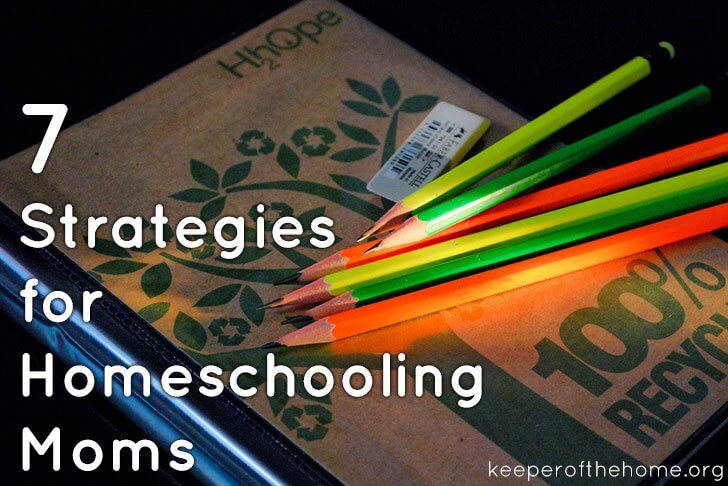Seven Strategies for Home Schooling Moms

Written by Natalie Klejwa, Guest Writer
When my oldest child was three years old, I began one of the most exciting and stretching challenges of my life. I started home schooling. Fifteen years later, I am teaching children in the 9th, 6th, 4th, 2nd, and 1st grades along with two toddlers. And that 3 year old? He’s almost 18 and will be graduating in the spring…from college!
I’ve fumbled my way along over the years…trying all kinds of different curriculum, styles, schedules, etc., and I’ve landed on seven strategies that bring it all together for me. Keep in mind that what works for one mama may not work for another one. God wired us all differently and gave us all unique, one-of-a-kind families! But even if just one idea I share can bring a little order to the chaos, hope for the weary, or vision for a brighter tomorrow…then I’d love to pass it along.
Strategy #1-Don’t be afraid to switch curriculum…in the middle of the school year!
For the most part, I have my favorite, tried and true curriculum picked out for the various subjects. But do you know how many times I’ve bought curriculum, tried it, and watched it “flop” for my children? Too many times to count. When we first started out, we had no money to spare…so this practice was not something I could do “lightly”…but we made it work by buying used curriculum whenever possible…and then selling our used curriculum to others if we found it wasn’t working.
One thing I learned the hard way is that if a curriculum was relatively unknown, or “fringy”…there was often a reason for that. I’ve had the most success with the larger, well known curriculum programs out there that get positive reviews year after year. If you feel “trapped” in the middle of the school year by the curriculum you are using…give yourself a break and quit. Find something that works better for you and your children. They won’t die of brain starvation while you are figuring things out and doing that necessary tweaking.
Strategy #2-Admit that each child is different and may need a different approach.
But that doesn’t have to mean you go bonkers! I have too many children to juggle a different math program for every single one. In other words, you won’t see me jumping and dancing and singing with my kinesthetic child while listening to a math audio program with my auditory child while watching a DVD with my visual child.
Here’s an example of what you might see over here. Our oldest child excelled using Saxon math…but our second child hit a wall with the same curriculum right around the 5th grade. So we switched to Math-U-See. That worked great until he hit Algebra. After a year of head banging, we switched again to Teaching Textbooks…and now he is sailing through math. The other kids are sticking with Math-U-See until and unless they also need a “switch”.
And keeping in mind strategy #1…we’ve had to do some of that switching mid-way through the year…and I’m awfully glad we did. What’s the point of wasting more time just for the sake of “finishing what we’ve started no matter WHAT?!” Remember one of the reasons why you’re home educating. You want to tailor an education to your individual child’s life. Roll with the punches, and enjoy the journey!

Strategy #3-Enjoy a flexible routine that works for your family.
I’ve tried the rigid scheduling method, and while it worked for a while with a couple of kids, I found myself on the verge of insanity as my family grew. Here is what ended up working for us. When I had 3 children in school, I would get a schedule book with a one-week layout on a two page spread and 7-8 subject spaces. One per child. I used to map out a week at a time, although recently I’ve started doing a month at a time…and I’ll simply write in the assignments for each day…for each subject…for each child.
Now that I have 5 school aged children, I bought a personal book for my 9th grader since he is learning to schedule his own assignments for each week…and then I have a “master book” that has enough scheduling spots in it for the other 4 children…so I have them all in one place. (I use The Well Planned Day, but there are other options out there.)
Here’s the deal: the kids don’t get free time until they are done with their assignments for the day. This motivates them to stay on task. Older kids can do most of their work independently. That includes correcting their own math work/tests. The only thing I need to continue to oversee with a student 6th grade and higher is their writing.
The youngest children need me for most of their work…so that is what I spend the bulk of my time doing every morning. (This should encourage you younger moms. Home educating is the most intense when they are younger. Keep sowing those seeds and working that soil! You will reap if you faint not!)
So I don’t care if they do math first…or science first…or practice their instrument first. The order doesn’t matter. And I don’t care if they take 3 hours to get their math done because they are in the mood to dawdle. It’s no skin off my back. They just have less free time.
For the older ones, that is enough motivation to keep on keeping on…until they finish all their assignments for the day. For the younger ones…they have me to keep them “on task”…and yes, while we do have days where I’m pulling my hair out spending an hour on a 10 minute math lesson with an ornery 6 year old, that is not the “norm”. (At least, that’s what I tell myself when I’m in the middle of it.)
Strategy #4-The more we get done in the morning…the better.
I used to plan a few subjects for morning…and a few more for the afternoon, but I found over time that little ones (and moms!) are freshest in the morning. You’ll sail through a lot more in a lot less time if you “hit the books” first thing after breakfast…and keep plowing through until you’re done. I’m usually completely finished with all my littles by lunch if I really stay focused. And then the afternoon is wide open for free time, naps, or projects.
Strategy #5-Who says school has to get done in 5 days out of 7?
A few years ago I started questioning everything I had always assumed about life, including education. I felt like I was in a real cultural “box”…and…why? Like there’s some kind of “box” police that makes sure you stay in? I decided to get out. That’s one of the reasons our oldest finished high school two years before he was “supposed to”.
Who says you have to be in “such-and-such” grade at “such-and-such” age? Who says you have to learn to read at age 5? Why not age 3? Why not age 9? Who says you have to spend 6-7 hours a day “doing school”? Who says a lot of things? Hey…if you are home educating…you’re already outside the box. Might as well kick that box down the street and be done with it for good. Once you’re out…you are free to make decisions that are best for each individual child…and for your very special family!
I purposefully plan their assignments so that the bulk of their weekly responsibilities are done in 4 days instead of 5. Oh…we still do some things on Friday…spelling, grammar, handwriting, etc. But they are usually the things that could be skipped in a pinch…and it wouldn’t hurt anything.
And that’s just the point. Things need to be skipped. Life happens. Kids get sick. You get pregnant. Dr. appointments. Unexpected phone calls that last too long. Out of town company…that stays too long. You know what I’m talking about. And if you’re already three days (or three weeks!) behind…that can start to feel overwhelming.
BUT…if you have this “extra day” built into your life…it really comes in handy! That ends up being “make up” day. And we use it all the time. Sometimes you’ll use it just to go to the zoo…or visit grandparents. The point is…it’s there when you need it.

Strategy #6-Have different “toddler spaces” to occupy the smallest members of the family during school.
I like to have my toddlers close, but I don’t want to be required to watch them like a hawk. So babies that are crawling or walking get “contained” close by, and often, the older toddler type will play with that baby happily while I am able to read or help the older ones with school.
My “containers”? Downstairs is our play room complete with couch, so I can actually let the toddlers go free down there while I read to older ones on the couch. It’s a safe room, and I can keep one eye on the book and one eye on the toddlers. They love that freedom, but if the baby gets into too much trouble, I do have a playpen nearby, and I’ll just put them in there and continue reading. If the baby fusses because they can see me, I’ll put some child-friendly music on, and the rest of us will move upstairs to finish up. I’ve noticed that babies do better playing on their own if they can’t visually see “mama”.
Another “container” is the Johnny Jump Up which is centrally located in our sun room and within view of the kitchen, the dining room, and the family room. I’ll let the baby jump and spin in that contraption while I make meals, fold laundry, or help older ones with their math or English.
A third “container” is the play yard in our family room. This is basically a plastic fence that makes a “yard” much bigger than a play pen. The baby can walk, crawl, dance, and play in there with 1-2 siblings. The rest of us can watch our science video in there, do more reading together, or just take a break while the baby is happy.
My other “baby strategy” is having the older children take a turn each day “babysitting” the baby…basically playing with them outside on the swing, letting them crawl in the yard, etc. While one child is “babysitting”…I can get a lot done with another child. And then they just switch!
Strategy #7-Plan for the most challenging time of the day…that hour right before dinner.
Around 4:00, for better or for worse, I allow the youngest children an hour to watch a DVD while I focus on dinner prep. Having all the little ones happily engaged in a DVD for an hour enables me to unwind, pick up the main level so it looks decent for my husband’s arrival, and get dinner on the table without dealing with 257 interruptions and 13 meltdowns which tend to make for a messy house, a late dinner, and a frazzled wife.
I do try to be selective about the entertainment our children watch. Educational DVDs like the Leap Frog series (which will teach your children to read by osmosis) are good choices. Another option is to let them watch old family videos. They love to see their older siblings when they were “little”…and enjoy watching themselves and their own silly antics on the screen as well. It brings back memories of past family fun and helps keep those memories alive!
We can all be visionary about education. Education is, bottom line, humans learning about our Creator and what He created. That means that education is happening in exciting ways every day, in every circumstance, in every life that lives under our roofs. Once we have that “big picture” truly settled in our hearts, the details…like what curriculum we use, what schedule we adopt, or which child learns what at what time…all come together somehow in God’s unique plan for each of us!
And we can joyfully rest in that.




I LOVE this post, Natalie! It was just what I needed today. I’ve known I needed to make some changes, even this early in the school year, but was resistant to it, feeling like we need to do it a “certain way,” or we’re not doing it “right.” I’m going to do my best to relax and go with the flow. Thank you, Natalie!
@Angela,
So glad if it can help anyone relax and ENJOY the journey! It’s always a GOOD thing to be uniquely YOU. God gave your children to you for a reason. : )
Great post! I love al the tips–especially the reminder that we are already “outside the box” and we can be creative at the school week. Thanks!
This is the best “strategies” post I have ever seen. Thank you for speaking to us homeschoolers that are already doing this on a daily basis but are still trying to organize the chaos. I love the way you simply explained getting out of “the box”. “Who says you have to learn to read at age 5? Why not age 3? Why not age 9?” Yes! I have I 5yo that I taught to read at age 4 but after he learned the basics (he can read all the Bob Books and almost anything that he can sound out) he got really frustrated at being asked to read. There would even be tears. I realized that even though he was intellectually able to read, he was just not ready to put his brian to work that much everyday. His brain wants to be occupied with other things, like playing and exploring. So, I put reading on the back burner. I now will just read to him anytime he wants with no pressure for him to perform, he simply gets to enjoy a great story. I have had so many people criticize me for this but I think it is what’s best for him. I have 3 others younger than him and I will not push any of them to tears over learning something they are “supposed to know by now”. Thanks again for all the encouragement.
@Becky @ Sowing Little Seeds,
I’m happy this was a boost of encouragement. It’s always good to remember that we can tweak things as we go…learning all the way.
I was interested in getting both your books do you have any deals if you purchase both?
Thanks so much for an excellent post. Homeschooling is a journey I am very excited to take my kids on. I was (poorly) homeschooled myself, and I am determined to do better for my children! Your hints and tips are excellent, and I can’t wait to have as many children as you learning in my home.
This post hit home for us – I am homeschooling a Pre K child right now with a 2.5 year old toddler as well (she does some schooling) and all of your points are things I have been thinking – you just put them into words for me! We also do the 4 days and then work in more on the 5th or do something fun! Great article – thank you for the validation of my thoughts!
@Ashlee,
It’s always nice to know we’re not alone! : )
Thanks for this great post! I am going to forward it to my husband. He really thinks we need to be schooling-at-home because “someday we might end up living next to a good school”. Now I’m going to read your bedtime post!
Thanks for this encouragement!
So, so good! Thank you for this article. I so appreciate your humor and grace. As a new homeschooling mom, your perspective feels like a breath of fresh air! So precise and so real. Thank you, thank you.
Kandace
I agree with some previous comments – one of the best homeschooling posts I’ve seen in a long time. I’m starting my 9th year of officially homeschooling my five children and I LOVED hearing how you do it!
What a practical post. Thank you so much for so many good ideas in one place. I love your box analogy… I certainly agree that it often needs to be kicked right down the street (and it sure is a relief)!
Yes, this is what I’ve been going through- changing schedules and perhaps curriculum. One works with one kids but not really the other! I need to give myself permission as a first timer that it’s okay and try again! Thanks!
What a fabulous article! Natalie is REAL and really encouraging, wise and practical in her counsel. Thank you for sharing what you’ve learned from the Lord along the way in your journey. I especially liked what you wrote in the final paragraph–that capped off the post in such a fitting way.
Great article- as a homeschooling family of 7, we’re always tweaking and adjusting our schedules and goals. Thanks!
Good stuff, for sure. We’ve just begun our homeschool journey…with one in Preschool, and one in Kindergarten. I find myself the principal/janitor, and Bible teacher so far. Loving the family time it affords us…
This is such a helpful post, Natalie. As someone who has been homeschooling only 3 years, I definitely look to more experienced moms to learn some of the tricks they have learned over the years. You addressed so many of the issues I struggle with… knowing when to change up curriculum, what to do with the toddler, that dreaded before-dinner hour. Have you been a fly on my wall? 🙂
I so agree that getting as much into the mornings as possible makes all the difference. We are committing this year to do school straight from 9-12, with only a 15 minute “recess”. It really pushes me to stay on focus and get things done, compared to last year when I felt more free to go into the afternoon if necessary. Problem was, either the afternoon schoolwork didn’t get done much of the time, or it took up time and energy that was needed for other things. So yes, mornings are key!
@Stephanie @ Keeper of the Home,
Thank you Stephanie. Bet there’s a whole lot more we could all “relate” to! It’s good to know we are not alone on this path. Thanks for the opportunity to share with your wonderful readers. It was fun!
I have a three year old son what should I be doing about
Learning for him.
Michele
Hey I am just wondering if you are in Canada? I would like to start homeschooling but feel lost where to even start. When I searched I just get confused and I do not know any other moms that do it and everyone seems to roll their eyes and say it is not proper when I even mention it.
Thank you so much!
I think its amazing what you do 🙂